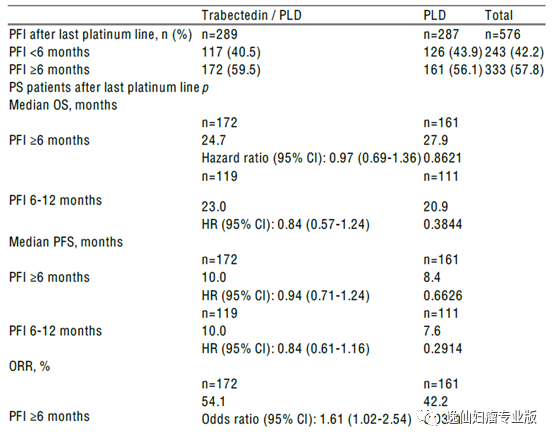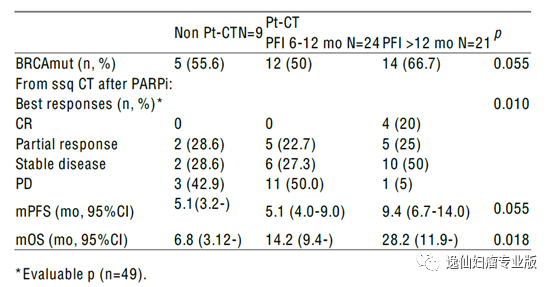复发性卵巢癌
1、Abstract 830P
Subanalysis of a randomized phase III study comparing trabectedin and PLD vs PLD alone in patients with recurrent ovarian cancer(ROC)
一项在复发性卵巢癌(ROC)患者中对比曲贝替定联合PLD与单药PLD的疗效的随机III期临床研究的亚组分析
B.J. Monk1, T. Herzog2, T. McGowan3
Background:
Trabectedin/PLD is approved in EU for patients with platinum-sensitive(PS) ROC. Monk et al(Gynecol Oncol 2020; NCT01846611)reported trabectedin/PLD vs PLD results in patients with ROC who progressed≥6months after 1st-line platinum and obtained a response to 2nd-line platinum. Based on an interim ad-hoc futility analysis requested by the IDMC, the study stopped early without survival benefit in the combination arm. For the original analysis, 266 events were considered(52% statistical power).
背景:曲贝替定联合PLD方案已经在欧盟获批用于铂敏感复发卵巢癌患者。Monk等报道了在一线含铂化疗后≥6个月出现进展,且二线含铂化疗仍然有效的卵巢癌患者中使用曲贝替定联合PLD vs PLD的研究结果(Gynecol Oncol 2020; NCT01846611)。根据IDMC要求的中期临时无效分析的结果,该研究因为联合治疗组无生存获益而提早终止。最初的分析是在266个事件数后进行的(52%的统计效力)。
Methods:
This post-hoc analysis evaluates the efficacy results(RECIST v.1.1) in the subset of women with a platinum-free interval(PFI) ≥6months after the last platinum, instead of considering PFI after the first platinum as done in the original analysis.
方法:此项事后分析评估了最近一次含铂化疗后的无铂间期(PFI)≥6个月的亚组患者的疗效结果(RECISTv.1.1)。而不是像初始分析那样,纳入的患者要求在第一次含铂化疗后的无铂间期(PFI)≥6个月。
Results:
Overall 333(57.8%) of patients included in the study had a PFI≥6 months following the last platinum. Although trabectedin/PLDdid not result in longer survival, there was a trend towards a favorable progression-free survival(PFS), with a 6.4-week prolongation compared to PLD(10.0 vs. 8.4 months) and a significant improvement in objective response rate(ORR: 54.1% vs 42.2%). Similarly to what was observed in the general population, a marked treatment benefit was observed with trabectedin/PLDin PS patients after last platinum line with a PFI 6-12 months and PS patients with BRCA1/2 mutations [trabectedin/PLD: n=48 vs PLD: n=52; OS: 47.8 vs20.0 months, Hazard ratio(95% CI): 0.34(0.17-0.67); PFS: 10.3 vs 7.6 months,0.61(0.37-1.02); ORR: 77.1% vs 44.2%, Odds ratio(95% CI): 4.24(1.65-11.19),p=0.001].Table: 830P
结果:本研究共纳入333名患者(57.8%),在最近一次含铂化疗后PFI均≥6个月。尽管曲贝替定联合PLD方案没有显示出更长的生存,但无进展生存期(PFS)有延长的趋势,与PLD方案相比延长了6.4周(10.0m vs. 8.4m),显著提高客观缓解率(ORR:54.1%vs 42.2%)。与在一般人群中观察到的情况相似,在最近一次含铂化疗后的PFI为6-12个月的铂敏感患者和BRCA1/ 2突变的铂敏感患者中,曲贝替定联合PLD方案有显著的治疗获益[曲贝替定联合PLD:n = 48 vsPLD:n = 52;OS:47.8m vs 20.0m,HR(95%CI):0.34(0.17-0.67); PFS:10.3m vs 7.6m,0.61(0.37-1.02); ORR:77.1%vs 44.2%, OR(95%CI): 4.24(1.65-11.19),p = 0.001]


Conclusions: Among all patients included in the study, only 57.8%were PS after the last platinum, precluding a reliable estimation of PFS or OS. Despite that, there is a trend toward improved PFS combined with significant improvement in ORR with trabectedin/PLD in this subset of patients. More pronounced benefits were observed in PS patients with a PFI 6-12 months and PS patients with BRCA 1/2 mutations.
结论:纳入研究的所有患者中,只有57.8%的患者在最后一次含铂化疗后为铂敏感状态,这排除了对PFS或OS的可靠估计。尽管如此,在该亚组患者中,使用曲贝替定联合PLD方案仍然有PFS改善和ORR显著改善的趋势。而且在PFI为6-12个月的铂敏感患者和BRCA 1/2突变的铂敏感患者中观察到了更为明显的益处。
2、Abstract 828P
Expected versus observed response to platinum-based chemotherapy after poly(ADP-ribose) polymerase inhibitor treatment for relapsed ovarian cancer
PARP抑制剂治疗复发性卵巢癌进展后再接受含铂化疗时的预期疗效与观察到的疗效的对比研究
T. Baert1, B. Ataseven1, M. Bommert1, N. Concin2
Background
Poly(ADP-ribose) polymerase inhibitors(PARPi) have become standard of care after response to platinum-based chemotherapy(CTX) for relapsed ovarian cancer(OC). Recently, PARPi have been approved as maintenance after first-line treatment as well. Response to platinum is the key predictor for response to PARPi treatment. Sensitivity and resistance to platinum andPARPi treatment partially overlaps. It remains unclear how prior progression onPARPi treatment might influence response to subsequent platinum-based CTX.
背景:PARP抑制剂(PARPi)已经成为复发性卵巢癌患者含铂化疗有效后的标准治疗方案。最近,PARPi也被批准为一线治疗后的维持治疗。对铂化疗有反应是PARPi治疗效果的关键预测因子。铂敏感以及铂耐药与PARPi治疗部分重叠。目前尚不清楚前期PARPi治疗后进展是如何影响后续的含铂化疗。
Methods
Patients undergoing platinum-based CTX for 2nd relapse of epithelial OC treated between 2011 and 2020 at the department of gynecologic oncology at Kliniken Essen-Mitte were included in this retrospective study. All patients provided written consent for retrospective analyses. Stratification parameter were defined as follows: Response to 2nd line CTX, PARPi maintenance, cytoreductive surgery for relapsed OC, BRCA status, PFS and treatment-free interval for platinum(TFIp) after 2nd line CTX. Primary outcome parameter was response to3rd-line platinum-based CTX in patient with and without prior PARPi treatment.
方法:本回顾性分析研究纳入了2011年至2020年在Essen-Mitte医院妇科肿瘤科就诊并接受含铂化疗的二次复发的上皮性卵巢癌患者。所有患者都签署了书面同意书。分层参数如下:二线含铂化疗的疗效、PARPi维持、复发性卵巢癌的二次减瘤手术、BRCA突变状态、PFS和二线含铂化疗后的无铂治疗间期(TFIp)。主要结果参数是在之前有和无PARPi治疗的患者中,三线含铂化疗的疾病缓解情况。
Results
After response to 2nd-line CTX, 57 patients received noPARPi(control) and 35 patients received a PARPi(n=16 olaparib, n=19 niraparib)as maintenance therapy. Baseline characteristics were well balanced between treatment groups. After PARPi maintenance 40%(14/35) of patients progressed on subsequent platinum-based CTX vs 9%(5/57) in the control group. Response to 3rdline platinum-based CTX, evaluated as complete response, partial response, stable disease and progressive disease was significantly altered by prior PARPi maintenance therapy(X2=14.19 -df 3- P=0.003).
结果:二线含铂化疗有效后,57例患者不接受PARPi(对照组),35例患者接受PARPi(16例奥拉帕尼,19例尼拉帕尼)维持治疗。两组基线特征平衡。在PARPi维持治疗后, 40%(14/35)的患者在随后的含铂化疗中进展,而对照组为9%(5/57)。接受PARPi维持治疗后,会显著改变三线含铂化疗的疾病缓解情况(评估为完全缓解、部分缓解、疾病稳定和疾病进展)。
Conclusions
Response to platinum-based 3rd line chemotherapy is lower than expected in patients treated with PARPi maintenance after response to 2ndline platinum-based chemotherapy, compared to patients who achieved a similar PFS and TFIp who did not receive a PARPi. Our data provide clinical evidence for altered sensitivity towards platinum-based CTX after prior PARPi treatment.
结论:与有相似的PFS和TFIp、但未接受PARPi维持治疗的患者相比较,在二线含铂化疗有效后使用PARPi维持治疗的患者三线含铂化疗疾病缓解率低于预期。我们的数据为既往PARPi治疗后含铂化疗的敏感性改变提供了临床证据。
3、Abstract 824P
Real-world-data(RWD) on platinum(Pt) outcomes afterPARP inhibitors(PARPi) progression in high grade serous ovarian cancer(HGSOC)patients(p)
高级别浆液性卵巢癌(HGSOC)患者中使用PARP抑制剂(PARPi)进展后对铂(Pt)化疗反应的真实世界研究(RWD)
Plaja Salarich1, I. Teruel García1, B. Pardo Burdalo2
Background
PARPi maintenance after Pt-based chemotherapy(CT)significantly improves progression-free survival(PFS) and PFS to subsequent(ssq) chemotherapy(PFS2) in relapsed HGSOC. However, crossed mechanisms of action and resistance between PARPi and Pt cast doubts on the benefit from ssqPt after PARPi progression. We provide RWD on this issue.
背景:在复发HGSOC患者中,含铂化疗后(CT)使用PARPi维持治疗可显著提高无进展生存(PFS)和无进展生存到后续化疗的时间(PFS2)。然而,PARPi和Pt的作用机制和耐药机制的交叉使人们对PARPi治疗进展后再使用Pt化疗的益处产生了怀疑。我们为这个问题上提供真实世界研究数据。
Methods
We included HGSOC p treated with ssq CT after progression to maintenance PARPi until 31st Dec 2019 in 3 large hospitals. Endpoints were overall response rate(ORR), median(m) PFS and overall survival(mOS) to ssq Pt after PARPi. Analysis were also performed according to 3 populations: pwho received ssq non-Pt CT, p with Pt-free interval(PFI) 6-12 months(mo) and pwith PFI >12 mo.
方法:截止2019年12月31日,我们在三家大医院中纳入了PARPi维持治疗进展后再后续使用化疗的HGSOC患者。研究终点为PARPi后再使用含铂化疗的总缓解率(ORR)、中位PFS和总生存率(mOS)。按照3类人群进行分析:后续接受非pt化疗组、无pt间隔(PFI) 为 6-12个月组和PFI>12个月组。
Results
54 p were identified(57.4 % BRCAmut). 4p(7.4%) received PARPi after 1st line CT, 25(46.3%) after 2nd line, and 25(46.3%) after ≥3rdline. 34p(63%) received olaparib and 20(37%) niraparib. mPFS of PARPi as maintenance in the recurrent setting was 7.5 mo and PFS2 15.4 mo. Distribution of ssq CT schemes and their best responses are shown in the table. ORR to ssqPt was 33.3%, and progression disease(PD) 28.6%. ORR in p who received ssqPt-free CT, p with PFI 6 12 mo, and p with PFI >12 mo were 28.6%, 22.7% and45%, respectively. The 4 identified complete responses(CR) occurred amongBRCAmut p receiving PARPi in the recurrent setting and PFI>12. Survival endpoints of ssq CT are shown in the table. mPFS and mOS were significantly longer in the PFI >12 subgroup versus the others. Survival did not change when excluding the 4p who received PARPi as 1st line(Table).
Table: 824P

结果:本研究共纳入54例患者(57.4%携带BRCA突变)。一线化疗后使用PARPi的有4例患者(7.4%),二线化疗后使用的有25例患者(46.3%),≥3线化疗后使用的有25例患者(46.3%)。34例患者接受奥拉帕利(63%),20例患者接受尼拉帕利(37%)。在复发患者中,PARPi维持治疗后的mPFS为7.5个月, PFS2为15.4个月。后续使用的化疗方案的分布以及最佳缓解情况如表所示。后续接受含铂化疗组的ORR为33.3%,疾病进展(PD)比例为28.6%。后续接受非铂化疗组、无铂间隔(PFI) 为 6-12个月组和PFI>12个月组的ORR分别为28.6%, 22.7% 和45%。4例达到完全缓解的患者是在复发状态下接受过PARPi治疗、携带BRCA突变且PFI>12个月。后续化疗的生存终点都在表格中列出。与其他组对比后发现,mPFS 和 mOS在PFI>12个月的亚组中显著延长。当排除一线化疗后接受PARPi的4名患者后,生存率没有变化(Table)。
Conclusions
Higher benefit from ssq Pt after PARPi was observed in the PFI>12 subgroup. Benefit from ssq Pt after PARPi in the PFI 6-12 subgroup was similar to benefit from CT in the non-Pt subgroup. The role of ssq Pt after PARPi in the PFI 6-12 subgroup warrants further research.
结论:在PFI>12个月的亚组中,在PARPi治疗进展后接受含铂化疗能够获得最好的生存获益。而在PFI为6-12个月的亚组中,生存获益与非铂化疗亚组相当。PARPi治疗进展后接受含铂化疗在PFI为6-12个月亚组人群中的作用仍需要更进一步的探索。